|
|
|
Sort Order |
|
|
|
Items / Page
|
|
|
|
|
|
|
| Srl | Item |
| 1 |
ID:
052382
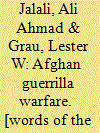

|
|
|
|
|
| Publication |
London, Compendium, 2001.
|
| Description |
xxii, 419p.
|
| Standard Number |
190257947X
|
|
|
|
|
|
|
|
|
|
|
|
Copies: C:1/I:0,R:0,Q:0
Circulation
| Accession# | Call# | Current Location | Status | Policy | Location |
| 046023 | 355.021809581/JAL 046023 | Main | On Shelf | General | |
|
|
|
|
| 2 |
ID:
105237
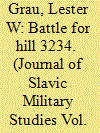

|
|
|
|
|
| Publication |
2011.
|
| Summary/Abstract |
The Battle for Hill 3234 was a small, bitterly-contested mountain fight that was a near-run thing, yet part of one of the most successful operations of the Soviet-Afghan War-Operation Magistral. Indeed, this combat by an under-strength 39-man paratrooper company has gained iconic status in Russian and inspired the popular movie and computer game 9th Company. The movie is great entertainment, but hardly accurate. This is the most-accurate account of this battle in the English language.
|
|
|
|
|
|
|
|
|
|
|
|
|
|
|
|
| 3 |
ID:
050966
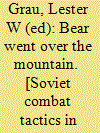

|
|
|
|
|
| Publication |
London, Frank Cass, 1998.
|
| Description |
xxxvii, 220p.hbk
|
| Series |
Cass Series on the Soviet (Russian) Study of War
|
| Contents |
Translated from Russian
|
| Standard Number |
0714644137
|
|
|
|
|
|
|
|
|
|
|
|
Copies: C:2/I:0,R:0,Q:0
Circulation
| Accession# | Call# | Current Location | Status | Policy | Location |
| 040136 | 958.1045/GRA 040136 | Main | On Shelf | General | |
| 048020 | 958.1045/GRA 048020 | Main | On Shelf | General | |
|
|
|
|
| 4 |
ID:
078275
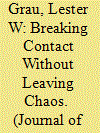

|
|
|
|
|
| Publication |
2007.
|
| Summary/Abstract |
There is a literature and a common perception that the Soviets were defeated and driven from Afghanistan. This is not true. When the Soviets left Afghanistan in 1989, they did so in a coordinated, deliberate, professional manner, leaving behind a functioning government, an improved military and an advisory and economic effort insuring the continued viability of the government. The withdrawal was based on a coordinated diplomatic, economic and military plan permitting Soviet forces to withdraw in good order and the Afghan government to survive. The Democratic Republic of Afghanistan (DRA) managed to hold on despite the collapse of the Soviet Union in 1991. Only then, with the loss of Soviet support and the increased efforts by the Mujahideen (holy warriors) and Pakistan, did the DRA slide toward defeat in April 1992. The Soviet effort to withdraw in good order was well executed and can serve as a model for other disengagements from similar nations.
During the Soviet occupation of Afghanistan from 1979-1989, its occupation force, the 40th Army conducted 220 independent operations and over 400 combined operations of various scales.1 Many of these large-scale operations accomplished little, since this was primarily a tactical commanders' war. Some large-scale operations, such as the initial incursion into Afghanistan, Operation Magistral, which opened the highway to Khowst and the final withdrawal, were effective because the force employed was appropriate to the mission
|
|
|
|
|
|
|
|
|
|
|
|
|
|
|
|
| 5 |
ID:
158503
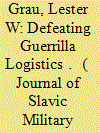

|
|
|
|
|
| Summary/Abstract |
In preparation for withdrawing from Afghanistan, the Soviets targeted key guerrilla logistics trans-shipment depots located in remote, difficult-to-access regions. One of these was located on the Iranian border in the vicinity of Herat. The Soviet 40th Army and Armed Forces of the Democratic Republic of Afghanistan launched a successful, hard-fought battle to take down this mountain fortress and destroyed large amounts of war stocks before withdrawing. It was a blow to guerrilla efforts, but was not decisive. Redundant guerrilla logistics networks were able to sustain the guerrilla effort following the battle.
|
|
|
|
|
|
|
|
|
|
|
|
|
|
|
|
| 6 |
ID:
070802
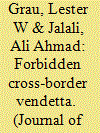

|
|
|
|
|
| Publication |
2005.
|
| Summary/Abstract |
In 1986, Soviet Special Forces conducted an unauthorized strike into Pakistan while attempting to wipe out a guerrilla base. The Special Forces were pinned down and had to call for Soviet air strikes to extricate themselves from an untenable position. This article discusses the planning, conduct and consequences of the mission.
|
|
|
|
|
|
|
|
|
|
|
|
|
|
|
|
| 7 |
ID:
054059
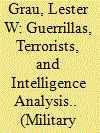

|
|
|
|
|
| Publication |
Jul-Aug 2004.
|
|
|
|
|
|
|
|
|
|
|
|
|
|
|
|
| 8 |
ID:
070804
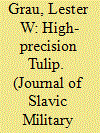

|
|
|
|
|
| Publication |
2005.
|
| Summary/Abstract |
The Soviets developed heavy mortars to destroy enemy field fortifications. In the late 1970s, Soviet designers began work on a precision-guided mortar round. The Soviet "Daredevil" 240mm high-precision mortar round has an optical-electronic tracking head that is guided onto the target by a laser beam. The 240mm mortar is mounted on a tracked chassis called the 2S4 "Tulip". In 1985, the Soviets sent the round to Afghanistan for combat testing. The article discusses the successful combat testing of the round in the Pandjshir Valley of Afghanistan.
|
|
|
|
|
|
|
|
|
|
|
|
|
|
|
|
| 9 |
ID:
074424
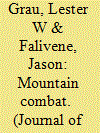

|
|
|
| 10 |
ID:
148388
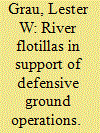

|
|
|
|
|
| Summary/Abstract |
In the history of warfare, ground and naval forces frequently have to cooperate. There are usually problems putting these two forces together since their missions, equipment, training, communications and mutual unfamiliarity get in the way. These problems are common during transport of ground force equipment and personnel aboard naval vessels, exacerbated during amphibious landings and assaults and very difficult when operating together along major rivers. This article analyzes the Soviet history of defensive river flotilla combat during the first period of the Great Patriotic War (World War II against Germany). It outlines missions, the operational environment, lessons learned, the command and control problems experienced between naval and ground forces and the challenges of conducting such operations.
|
|
|
|
|
|
|
|
|
|
|
|
|
|
|
|
| 11 |
ID:
052091
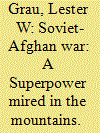

|
|
|
|
|
| Publication |
March 2004.
|
| Summary/Abstract |
The Soviet-Afghan War involved more than the Soviets and Mujahideen resistance. Afghan communists (the DRA) were involved in the immediate struggle and a large number of countries supplied the Mujahideen during this "Cold War" hot war. Their struggle and their lessons are outlined. The author does not usually write about footnotes, but he wrote this article during a trip to Iraq and lacked his reference library. Needless to say, he drew on his knowledge about the war and the knowledge he gained from noted authorities on the subject. These include Ali Jalali, Barnett Rubin, Riaz Khan, Mohammad Youssaf, Brace Amstutz, Artem Borovik, Aleksandr Lyakhovskiy, Aleksandr Mayorov, Scott McMichael, Makhmut Gareev, David Isby, Boris Gromov, Rasul Rais, and Louis Dupree.
|
|
|
|
|
|
|
|
|
|
|
|
|
|
|
|
|
|
|
|
|